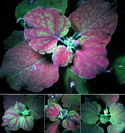View Item
- xmlui.general.dspace_homeCentros e Institutos de InvestigaciónCICVyA. Centro de Investigación en Ciencias Veterinarias y AgronómicasInstituto de BiotecnologíaArtículos científicosxmlui.ArtifactBrowser.ItemViewer.trail
- DSpace Home
- Centros e Institutos de Investigación
- CICVyA. Centro de Investigación en Ciencias Veterinarias y Agronómicas
- Instituto de Biotecnología
- Artículos científicos
- View Item
Transgenic expression of tobacco mosaic virus capsid and movement proteins modulate plant basal defense and biotic stress responses in Nicotiana tabacum
Abstract
Plant viruses cause metabolic and physiological changes
associated with symptomatic disease phenotypes. Symptoms involve direct and indirect effects, which result in disruption
of host physiology. We used transgenic tobacco expressing a variant of Tobacco mosaic virus (TMV) coat protein (CPT42W)
or movement protein (MP), and a hybrid line (MP×CPT42W) that coexpresses both proteins, to study the plant response
to individual viral proteins. Findings
[ver mas...]
Plant viruses cause metabolic and physiological changes
associated with symptomatic disease phenotypes. Symptoms involve direct and indirect effects, which result in disruption
of host physiology. We used transgenic tobacco expressing a variant of Tobacco mosaic virus (TMV) coat protein (CPT42W)
or movement protein (MP), and a hybrid line (MP×CPT42W) that coexpresses both proteins, to study the plant response
to individual viral proteins. Findings employing microarray analysis of MP×CPT42W plants and silenced mp×cpT42W* controls
revealed that altered transcripts were mostly downregulated, suggesting a persistent shut-off due to MP×CPT42W expression. Next, we showed that MP triggered reactive oxygen species (ROS) accumulation, reduction of total ascorbate, and expression of ROS scavenging genes. These effects were enhanced when both proteins were coexpressed. MP and MP×CPT42W plants showed increased levels of salicylic acid (SA) and SA-responsive gene expression. Furthermore, these effects were partially reproduced in Nicotiana benthamiana when GMP1 transcript was silenced. CPT42W seems to be playing a negative role in the defense response by reducing the expression of PR-1 and RDR-1. MP and MP×CPT42W transgenic expression promoted a recoverylike phenotype in TMV RNA infections and enhanced susceptibility to Pseudomonas syringae and Sclerotinia sclerotiorum. The individual effects of viral proteins may reflect the ability of a virus to balance its own virulence.
[Cerrar]

Fuente
Molecular plant-microbe interactions 25 (10) : 1370–1384. (2012)
Date
2012
ISSN
0894-0282
1943-7706 (online version)
1943-7706 (online version)
Formato
pdf
Tipo de documento
artículo
Palabras Claves
Derechos de acceso
Abierto
 Excepto donde se diga explicitamente, este item se publica bajo la siguiente descripción: Creative Commons Attribution-NonCommercial-ShareAlike 2.5 Unported (CC BY-NC-SA 2.5)
Excepto donde se diga explicitamente, este item se publica bajo la siguiente descripción: Creative Commons Attribution-NonCommercial-ShareAlike 2.5 Unported (CC BY-NC-SA 2.5)


